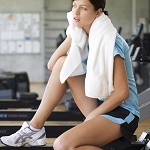Germs at the Gym? Really?

I try to learn more about health and related topics and one source of new information I read are the newsletters produced by doctors, medical people, sports people and others which flood my inbox every day. Last week one of them caught my attention. It was titled ‘Seven Places Germs Hide at Your Gym’.
I found that interesting; first because I spend some time in the gym myself and second because ‘germophobia’ is a heavily oversold topic in many areas of our lives. From anti-bacterial soaps, washes, dish cleaners to anti-microbial creams and fabrics, we are deluged by the message the germs are bad. In our society, germs are dirty and associated with unclean things.
While they may be partly true, it is also not really the case, because we rely so heavily on ‘germs’ for our health and for so many life processes on earth. There are 10 times more bacterial cells (germs) in our bodies than our body cells and they account for between 1% and 3% of our body weight.
Thus our war against germs is not quite as simple as it seems and anti-bacterial products probably kill as many bad bacteria as they do good ones.
Back to the Gym
The gist of the article we are discussing was to provide some well-meaning advice to avoid coming into contact with the germs that supposedly lurk in vast numbers at our gyms. Germs that we unwittingly bring home with us after our workouts.
Here are some of the pearls of wisdom:
- Don’t drink from water fountains and don’t touch the handles or the bowl because they can contain more bacteria than a toilet. Rather bring a water bottle and if you have to use the water fountain, always wash your hands after touching the tap. What crap! Can you imagine going back to the bathroom and then washing your hands? What do you do after you touch the tap in the bathroom? Maybe the solution is to wear gloves.
And while were thinking about touching things in the gym, how about all the equipment we have to touch? Maybe we should just run on the treadmill and avoid touching anything except the treadmill controls.
- Yoga mats also came in for a lambasting. They are full of sweat from the previous people who used them. The advice here was to bring your own mat.
Think this through for a moment. Assume you bring your own mat. Where do you place it? On the ground of course. And what’s on that ground under your mat? Why, it’s covered in all the bacteria from the other ‘dirty’ mats you are trying so hard to avoid. So after a few uses, your ‘clean’ mat becomes just as ‘dirty’ with bacteria as the gym mats.
- According to the article, showers and locker rooms are also to be avoided at all costs. They have humid areas that breed not only bacteria but also wart causing organisms, fungi (like athlete’s foot). The sage advice given is to avoid these places completely. If you have to go into the shower area, they you are advised to bring anti-microbial soap and to wear flip-flops to keep your feet pure. If you happen to use the sauna, then sit on a towel! Sadly just like the gym mat it too will become contaminated after it touches the bench and other surfaces. As will you skin when you use the towel to dry yourself later.
So, what’s the take-away here?
My feeling is that we are exposed to an astonishing diversity of bacterial, viral and fungal threats as well as an equal quantity of ‘germly’ benefactors every moment of our lives. The same critters that menace us at the gym are lurking in equal numbers at our workplaces, in the transport we use, in our homes and on every surface we come into contact with.
The best course of action is to wash your hands when you get home or when they come into contact with dirty surfaces and don’t use an anti-microbial soap, which kills the good guys that protect your skin at the same time. Exercise basic caution when interacting with people who have flu or other contagious illnesses and when visiting hospitals.
Otherwise, just keep clean and live your life in harmony with the trillions of ‘germs’ you come into contact with each day. Trust the good critters that live on you to look after you, as they have been doing since humans began to live in communities.


